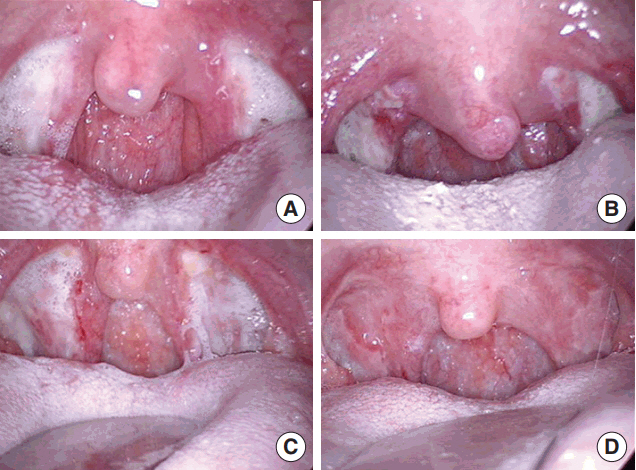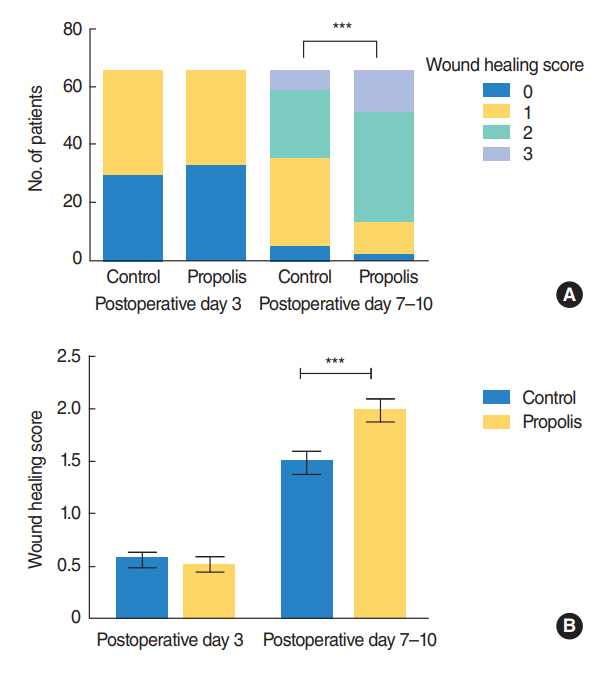Clin Exp Otorhinolaryngol.
2018 Jun;11(2):146-150. 10.21053/ceo.2017.00647.
Effect of Topical Propolis on Wound Healing Process After Tonsillectomy: Randomized Controlled Study
- Affiliations
-
- 1Department of Otolaryngology-Head and Neck Surgery, Dankook University College of Medicine, Cheonan, Korea. lsj72@dankook.ac.kr
- 2Medical Laser Research Center, Cheonan, Korea.
- 3Beckman Laser Institute Korea, Cheonan, Korea.
- 4Laser Translational Clinical Trial Center, Dankook University, Cheonan, Korea.
- KMID: 2412673
- DOI: http://doi.org/10.21053/ceo.2017.00647
Abstract
OBJECTIVES
The post-tonsillectomy pain and post-tonsillectomy hemorrhage are the two main problems after tonsillectomy. The aim of this study was to investigate the beneficial effects of water soluble ethanol extract propolis on post-tonsillectomy patient.
METHODS
One hundred and thirty patients who underwent tonsillectomy or adenotonsillectomy were randomly divided into the control and propolis groups, each including 65 patients. The propolis group was applied with propolis orally immediately after surgery and by gargle. The pain scores were assessed on post-tonsillectomy 0, 1st, 2nd, 3rd, and 7th-10th day using a visual analogue scale score. Postoperative wound healing was evaluated by scoring pinkish membrane of tonsillar fossae on postoperative days 3 and 7-10. The incidence of post-tonsillectomy bleeding was examined in each group.
RESULTS
Post-tonsillectomy pain was significantly less in propolis group compared to control group on postoperative days 3 and 7-10. Post-tonsillectomy hemorrhage was significantly less in the propolis group compared to the control group (P < 0.05). The wound healing was significantly better in the propolis group compared to the control group on postoperative day 7-10 (P=0.002).
CONCLUSION
Applying the propolis to post-tonsillectomy wound showed beneficial effect of reducing postoperative pain, preventing hemorrhage, and accelerating of wound healing of tonsillar fossae.
Keyword
MeSH Terms
Figure
Reference
-
1. Magro Filho O, de Carvalho AC. Application of propolis to dental sockets and skin wounds. J Nihon Univ Sch Dent. 1990; Mar. 32(1):4–13.2. Velikova M, Bankova V, Marcucci MC, Tsvetkova I, Kujumgiev A. Chemical composition and biological activity of propolis from Brazilian meliponinae. Z Naturforsch C. 2000; Sep-Oct. 55(9-10):785–9.
Article3. Khayyal MT, el-Ghazaly MA, el-Khatib AS, Hatem AM, de Vries PJ, el-Shafei S, et al. A clinical pharmacological study of the potential beneficial effects of a propolis food product as an adjuvant in asthmatic patients. Fundam Clin Pharmacol. 2003; Feb. 17(1):93–102.
Article4. Martin MJ, La-Casa C, Alarcon-de-la-Lastra C, Cabeza J, Villegas I, Motilva V. Anti-oxidant mechanisms involved in gastroprotective effects of quercetin. Z Naturforsch C. 1998; Jan-Feb. 53(1-2):82–8.5. Samet N, Laurent C, Susarla SM, Samet-Rubinsteen N. The effect of bee propolis on recurrent aphthous stomatitis: a pilot study. Clin Oral Investig. 2007; Jun. 11(2):143–7.
Article6. Viuda-Martos M, Ruiz-Navajas Y, Fernandez-Lopez J, Perez-Alvarez JA. Functional properties of honey, propolis, and royal jelly. J Food Sci. 2008; Nov. 73(9):R117–24.
Article7. Akbas Y, Pata YS, Unal M, Gorur K, Micozkadioglu D. The effect of fusafungine on post-operative pain and wound healing after pediatric tonsillectomy. Int J Pediatr Otorhinolaryngol. 2004; Aug. 68(8):1023–6.
Article8. Raja SN, Meyer RA, Campbell JN. Peripheral mechanisms of somatic pain. Anesthesiology. 1988; Apr. 68(4):571–90.
Article9. Ibi M, Matsuno K, Shiba D, Katsuyama M, Iwata K, Kakehi T, et al. Reactive oxygen species derived from NOX1/NADPH oxidase enhance inflammatory pain. J Neurosci. 2008; Sep. 28(38):9486–94.
Article10. Szeremeta W, Novelly NJ, Benninger M. Postoperative bleeding in tonsillectomy patients. Ear Nose Throat J. 1996; Jun. 75(6):373–6.
Article11. Weimert TA, Babyak JW, Richter HJ. Electrodissection tonsillectomy. Arch Otolaryngol Head Neck Surg. 1990; Feb. 116(2):186–8.
Article12. Perkins JN, Liang C, Gao D, Shultz L, Friedman NR. Risk of post-tonsillectomy hemorrhage by clinical diagnosis. Laryngoscope. 2012; Oct. 122(10):2311–5.
Article
- Full Text Links
- Actions
-
Cited
- CITED
-
- Close
- Share
- Similar articles
-
- Nutritional Support and Wound Healing
- Case reports: treatment of oral soft tissue lesions and wounds with high functional tooth paste made from nanoemulsion gel
- Homologous fibronectin enhances healing of excised wounds in rats
- Effects of 0.1% Dexamethasone on Experimental corneal Epithelial Healing Following Alkali Wounds
- The underrated role of cold drinks in post-tonsillectomy care: a pediatric case study





